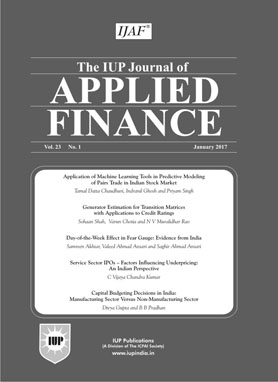
Mar'19
The IUP Journal of Case Folio
Archives
Rana Kapoor's Responsible Leadership at the Crossroads?
The case describes the responsible leadership and vision of Rana Kapoor, Managing Director and CEO of India-based Yes Bank, which enabled the bank achieve several milestones both in business and sustainability parameters. Since the inception of the bank, Kapoor had proved his exceptional leadership not only in terms of the business performance of the bank, but also in the way the bank mainstreamed sustainable development, sustainable investing, corporate social responsibility, and environmental stewardship as its business development goals. His holistic responsible banking and knowledge-driven approach and focus on sustainable investment created sustained value for its stakeholders, through social, economic, and environmental dimensions. This differentiated approach created a paradigm in the Indian banking sector through continuous innovation and excellence, in the process winning Kapoor several awards and accolades, both nationally and globally. Kapoor, credited with establishing the credentials of Yes Bank, was likely to step down by January 2019. Despite the bank shareholders giving their approval for Kapoor’s reappointment for another three years, India’s central bank, the Reserve Bank of India (RBI), decided to limit his tenure and asked the Board to find a successor. Kapoor had earned the ire of the RBI as the bank had wrongly classified loans which should have counted as non-performing. Though the bank decided to elevate senior group presidents Rajat Monga and Pralay Mondal as executive directors in order to ensure a smooth transition, the fact that Kapoor would not be playing an active role cast doubts on the bank’s future performance. Following the RBI’s action, investors were concerned over the uncertainty surrounding the bank’s leadership, which could impact its growth prospects. Going forward, it remained to be seen whether the new CEO would be able to carry on with the existing strategy of the bank.
Apple's Battle with the FBI: Privacy Versus National Security
Apple Inc. (Apple), the world’s biggest tech company, updated its privacy policy and security features during the launch of the iOS 8 in 2014. In order to protect its customer’s data privacy, Apple refused to provide information to FBI from a phone used by a terrorist involved in San Bernardino terrorist attack in December 2015. However, FBI accessed data from the terrorist’s iPhone with the help of professional hackers. This news brought new challenges for Cook and his team to find and fix the flaw that had allowed hackers to crack the passcode and protect the customers’ privacy. The case provides information for not only discussing the future of Apple’s privacy strategy but also the ethical issues behind Apple’s decision.
Goodfeel - A Specialized Feminine Garment for Tackling a Social Problem
On June 22, 2017, Ashutosh Joshi (Ashutosh) and his wife, Sharada, launched goodfeel, a specialized undergarment for women that would allow them to relieve themselves in a standing position. They got the idea for this product when their daughter was diagnosed with Urinary Tract Infection (UTI), which they felt was the result of the ill-maintained toilets at school. Many girls and women in India were left susceptible to UTI as there were an inadequate number of public toilets available and the condition of those that were there was pathetic. This led to many women avoiding the toilets, which put them at a health risk. Moreover, due to age or some health conditions, some women were not able to sit down on toilets to relieve themselves. Ashutosh and his wife wanted to take care of this problem, and after multiple iterations, their seventeenth prototype was commercialized under the brand name ‘goodfeel’. The product underwent rigorous trials, in which more than 4,000 women participated before it was commercialized. While their innovative product attracted accolades from the industry, Ashutosh and Sharada also faced certain challenges. According to Ashutosh, the raw materials used for manufacturing the product were costly. The cost along with having to sell an unconventional and intimate feminine product presented Ashutosh with a number of challenges. What can Ashutosh do to communicate the benefits of the product in a society where women find the act of relieving themselves outside the peripheries of their own house a daunting task? How can the target audience be convinced to adopt the product in a culture where it is considered taboo for a woman to even ask for a public toilet?
Brand IIT: From 1951 to 2016
Indian Institute of Technology (IIT) had evolved into a world-known brand for high quality education. Although IITs were run by Government of India, they had high level of autonomy. IITs were believed to have developed into high-class educational institutes due to their freedom to choose their students and to design their courses. In 2008-09, the Indian government decided to increase the number of IITs from 6 to 13 in a short span of time without adequate planning. Seven more were established in 2014-15, besides conversion of a few existing technical institutes together leading to a total number of 23 IITs by 2016. In 2013, the Indian government also decided to change the student selection procedure. Students and parents, alumni, professors and industries recruiting from IITs believed that brand IIT would get affected due to the government’s decisions. This case studies the evolution of the IIT brand, its growth and impact of government decisions. The objective of the case is to recognize the branding of higher education institutions with respect to governmental interventions, global market forces, student requirements, faculty perspectives and overall stakeholder’s expectations.